The new GENCON 2022 charterparty
BIMCO’s GENCON charter was first developed in 1922. It has been considered BIMCO’s flagship contract and it is the most widely used voyage charter party in the dry bulk sector.
The last revision was published in 1994. That revision was, to a large extent, triggered by some significant English court cases that cast doubt on the understanding and intention behind important clauses in GENCON 76 such as the General Strike Clause. The intention then was not to rewrite GENCON 76, but simply to clarify and update it where necessary. However, a lot has happened since 1994. The shipping industry has become much more complex and regulated, with both shipowners and cargo owners being subject to obligations that were never thought of in 1994.
The new GENCON 2022 is a comprehensive rewriting of the charter and the main changes to it are discussed below.
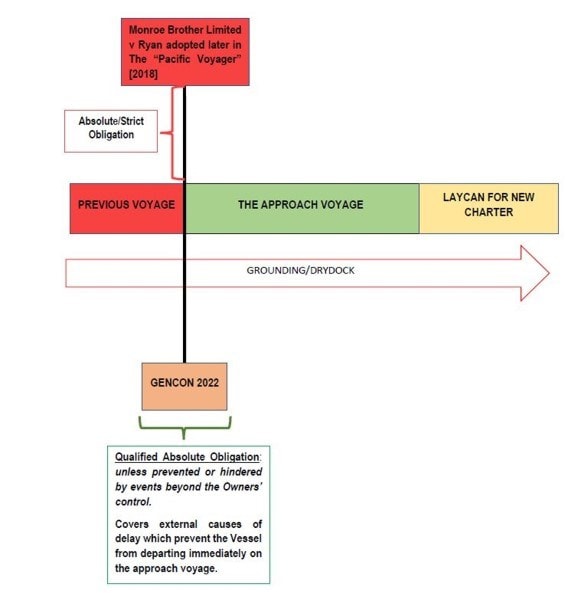
1) Absolute obligation on the owner to commence the approach voyage unless vessel is “prevented or hindered by events beyond the owner’s control” (Clause 1)
The absolute obligation on the owner to commence the approach voyage by a date when it is reasonably certain that the vessel will arrive at the loading port on or around the Expected Ready To Load date ("ERTL") is now subject to an exception if the vessel is “prevented or hindered by events beyond the Owners’ control” (Clause 1.a).
This avoids the harshness of the rule in Monroe Brothers Limited v Ryan that the general exceptions (Clause 18) cannot be relied upon before the approach voyage has commenced (see “The Pacific Voyager” [2018]).
2) Significant change in owner’s responsibility (Clause 2)
This clause has significantly been amended.
The previous versions provided owners with wide-ranging exclusions of liability for loss, damage or delay in delivery of the goods carried, by which, the owner would only be liable for unseaworthiness or some other cause if it was due to the personal want of due diligence on the part of the individuals who control the management of the vessel (this is different from the neglect or default of employees, for example, under the Hague Visby Rules). As a result, it was common to incorporate the Hague Visby rules, namely so as to blunt the harshness (from a charterer’s perspective) of this clause as well as to avoid potential prejudice to P&I cover by not having incorporated the Hague or Hague-Visby Rules into the charter.
Whilst the 2022 version still does not incorporate the Hague Visby Rules (“HVR”), clause 2 is amended to provide owners with the benefit of the HVR. As a result, although the owner loses the wide-ranging exclusions for loss, damage or delay in delivery of the goods carried:
- The owner benefits from the exceptions to liability included in the HVR Art 4 rule 2 and the 1 year time bar. Whilst the time bar
to bring a claim against the owner is one year, it is important to keep in mind
that a claim by owners against charterers is still subject to the usual 6 year
contractual time bar (tactically an owner could wait to bring a claim against
the charterer after a year in order to defeat any counter claim by the
charterer)
- The owner only has a due diligence obligation to make the seaworthy “at the commencement of each cargo loading”, and “at the commencement of each cargo-carrying voyage”. This is narrower than the HVR where the obligation to exercise due diligence applies “before and at the beginning of the voyage”.
3) New cargo clause (Clause 3)
This clause did not exist in the previous GENCON versions. It defines the parties’ responsibilities for various cargo-related matters and has the effect of allocating to the charterer the responsibility for compliance with a wide variety of regulations imposed on shipowners (cargo documentation, lashing and securing materials to be disposed of in accordance with all applicable laws and regulations etc.)
Clause 3 also deals with common issues relation to bulk cargo, part cargo, cargo harmful for the environment and lighterage. For example, with regards to bulk cargo, where the cargo is to be delivered to more than one receiver or discharged at more than one berth, other than in accordance with the vessel’s natural segregation, the charterer will be responsible for any resulting claim for short delivery or over-landing caused thereby, including any fines or legal costs.

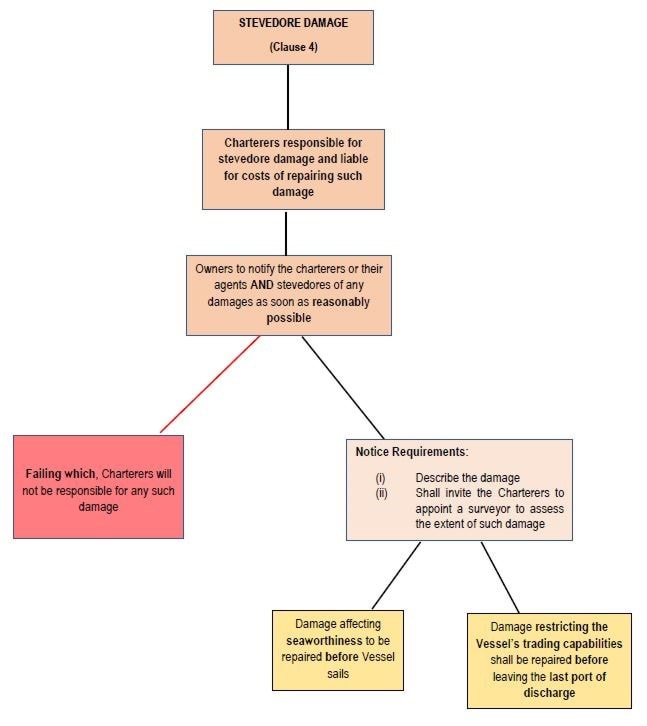
4) Loading, discharging and stevedore damage (Clause 4)
Formerly clause 5, this clause allocates the risk, responsibility and expense of loading and discharging operations on the charterer. This clause has been slightly amended in that the cargo operations are subject to the supervision of the Master which aligns it with clause 8 of the NYPE charter.
Clause 4 also deals with stevedore damage. The charterer will be responsible for stevedore damage. The owner must notify the charterer and the stevedores of the damage as soon as reasonably possible, failing which the charterer shall not be liable. The notice must describe the damage and invite the charterer to appoint a surveyor.
5) Cargo Fumigation (Clause 5)
This is a new clause and places responsibility for fumigation on charterers. Fumigation shall be at the Charterers’ cost, expense, risk and responsibility. It is charterers responsibility to deal with all regulation relating to fumigation.
6) Deck Cargo (Clause 6)
Owners’ prior consent is required for the carriage of deck cargo and places the risk of loss or damage to deck cargo on the Charterers, including claims arising from the negligence of the Owners.
7) Freight (clause 7)
All freight other than lump-sum freight is earned progressively as the cargo is loaded whilst lump-sum freight is earned only on completion of loading.
Freight is non-returnable even if ship or cargo is lost and Charterers are entitled to demand “Freight paid” bills of lading only where the freight has been paid in full.
8) Tendering the Notice of readiness (Clause 9)
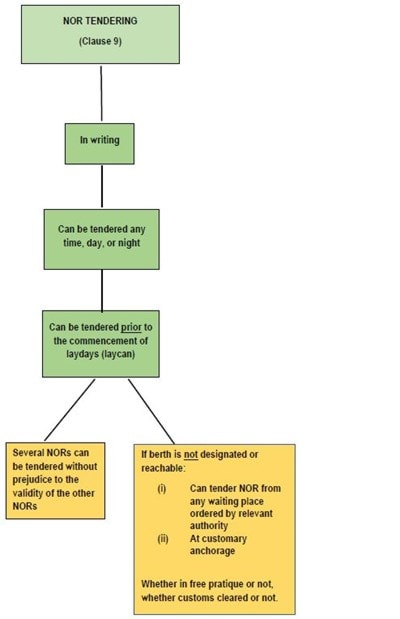
The Notice of Readiness (NOR) must be tendered in writing and can be served at any time, day or night. The NOR can be tendered prior to the first day of laydays however, laytime shall not begin before that time unless cargo operations are sooner commenced. Clause 9 states the position under English case law, namely that several NORs can be tendered without prejudice to the validity of the other NORs.
If the loading or discharging berth is not designated or reachable on the Vessel’s, Owners will be entitled to tender the NOR whether in berth/port or not, whether in free pratique or not, whether customs cleared or not.
9) Notice of readiness and state of the holds (Clause 9)
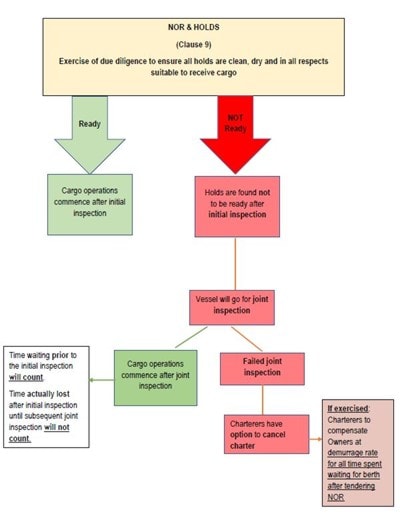
Before tendering Notice of Readiness, the Owners must exercise due diligence to ensure that all holds are clean, dry and in all respects suitable to receive the cargo.
If the vessel tenders an NOR and the vessel’s holds are then found on inspection not to be ready in all respects, time waiting prior to the initial inspection will count. However, time actually lost after the initial inspection and until the Vessel is subsequently joint re-inspected will not count.
If after a subsequent joint reinspection the holds are still not ready, Charterers will have the option of cancelling the Charter by written notice within twelve (12) hours after the expiry of a grace period of 96 hours or by the cancellation date, whichever is the later, provided the Vessel is free of cargo.
If the charterer chooses to cancel they will have to compensate owners at the demurrage rate for all time spent waiting for a berth after tendering Notice of Readiness.
10) Laytime (clause 10)
This clause incorporates the BIMCO Laytime Definitions for Charter Parties 2013. The charter also makes it clear that laytime runs continuously unless the actual working of the vessel is prevented by weather. Weather under the charter is therefore an exception rather than an interruption to laytime as under Gencon 1994 (which stated “weather permitting”).
11) Running of laytime (Clause 12)
There are several new provisions with regards to the running of laytime:
i) Time and costs for shifting between berths in the same port will be for the charterer’s account.
ii) Should time be lost on account of environmental or public health issues relating to the cargo (e.g. dust), time will count and any costs will be for the charterer’s account.
iii) The completion of cargo operations and therefore when laytime and demurrage cease is now defined. The charterer is also given 3 hours after the completion of cargo operations at each port or place to provide a full set of cargo documents, after which, laytime or demurrage shall start again, This provision has the advantage of simplifying an owner’s position since an owner’s claim for damages for detention under the old Gencon charter party , often revolve around a dispute as to when the owner’s claim for detention starts and the applicable rate of damages that an owner is entitled to claim.
12) Cancelling (Clause 14)
Where the vessel has failed to tender its NOR by the cancelling date, the charterer has the option of cancelling the charter, however this must be done within 48 hours of the cancellation date.
Where the owner has informed the charterer that the vessel is running late and will miss her cancelling date and the owner has given a new ETA, the charterer has 48 hours from the owner’s notification to accept that new ETA as the revised cancelling date or cancel the charter.
This clause is therefore more flexible than GENCON 1994 since it gives the charterer the option to accept the owner’s new ETA or, alternatively, to cancel the charter party whereas under the 1994 version the new cancelling date was deemed to be the seventh day after the new readiness date given by the owner. (Note that this option to provide a new ETA is available to owners only once.)
13) Suspension and Termination (new Clause 16)
This new clause gives the owner enhanced rights in the event of non-payment of sums due under the charter and is similar to existing provisions under time charters, as follows:
i) Should the charterer fail to pay freight, deadfreight, demurrage or other compensation in accordance with the charter, the owner is entitled at any time to suspend performance.
ii) Furthermore, if after a notice period of 96 hours charters fail to pay outstanding sums the owner shall be entitled to terminate the charter and/or to discharge the cargo at any port or place, and such action shall not be considered to be a breach or deviation under any relevant bills of lading.
As with “anti-technicality notices” under time charters, it is expected that the notice will have to follow similar requirements as to the way it is drafted (see our guide on suspension and withdrawal in a nutshell).14) Strikes (Clause 17)
This clause is a significant reworking of the traditional General Strikes Clause which appears in previous versions of GENCON.
If no cargo is on board the vessel, the owner may seek affirmation from the charterer that they will ignore the strike. If the charterer declines or ignores this request, the owner will have the right, but not the obligation, to cancel the charter.
If at load or discharge port a strike affects the actual loading/discharging of the ship, laytime will run normally and any demurrage will be at 50% for up to 10 days, thereafter at the full rate. If the strike is prolonged beyond 25 days the owner will be entitled to be paid beyond this period, the greater of the demurrage rate and the ship’s then market rate.
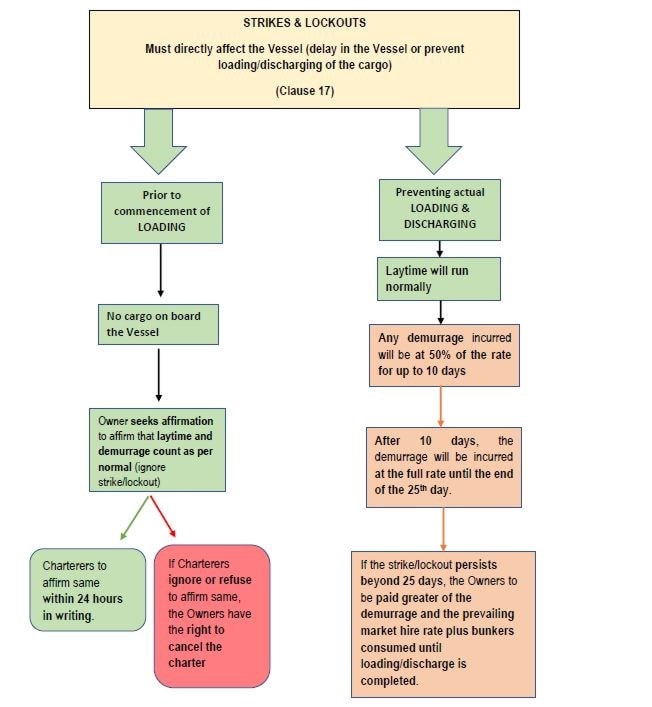
15) General Exceptions Clause (clause 18)
Previously, and unlike in many other charter forms, there was nothing in the GENCON to excuse a charterer from a breach arising from events beyond his control.
The General Exceptions clause provides a mutual exemption from liability for adverse effects which are beyond the control of the party claiming its benefit. However, the charter otherwise remains in full effect, including the running of laytime and demurrage and does not affect the charterer’s obligations to make payment of any sum due to owners under the charter.
16) Incorporation of existing BIMCO clauses (but no “force majeure” clause)
As with the NYPE 2015, BIMCO has taken the opportunity to incorporate a number of its existing standard form clauses, including covering Ice, ISPS, Sanctions, War Risks and Piracy.
Members should however note that no “force majeure” clause is incorporated in this charter.
